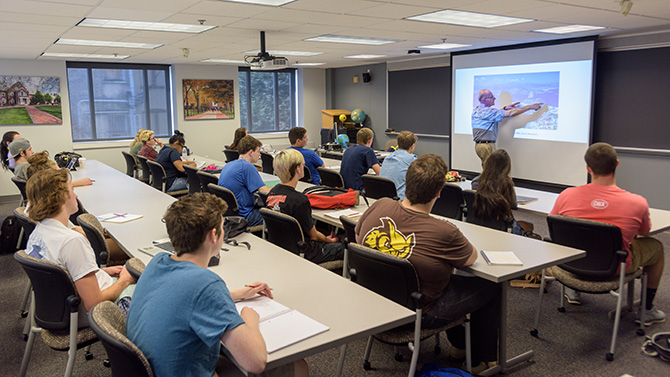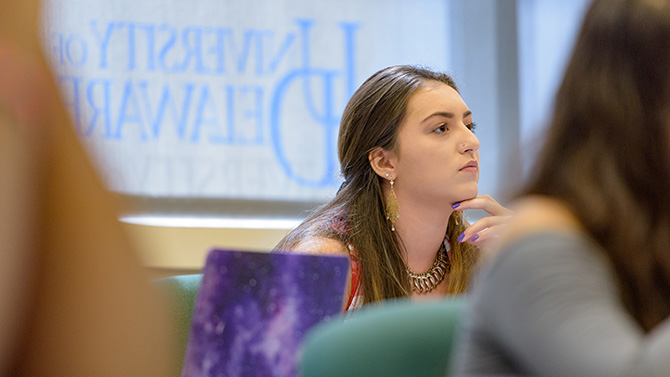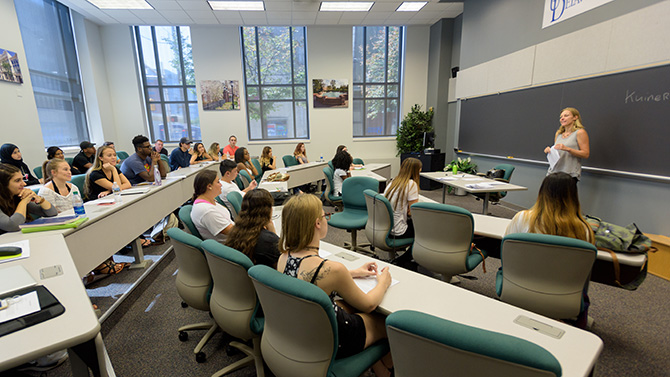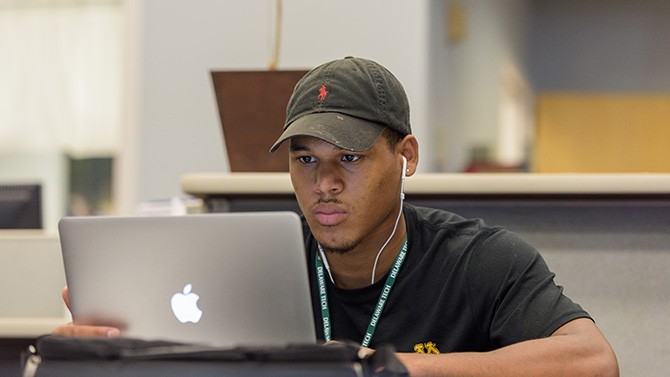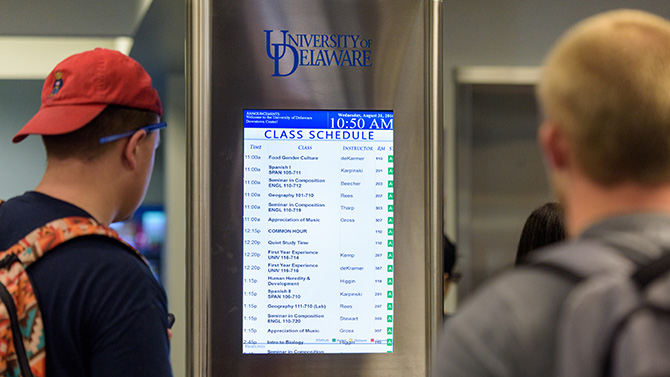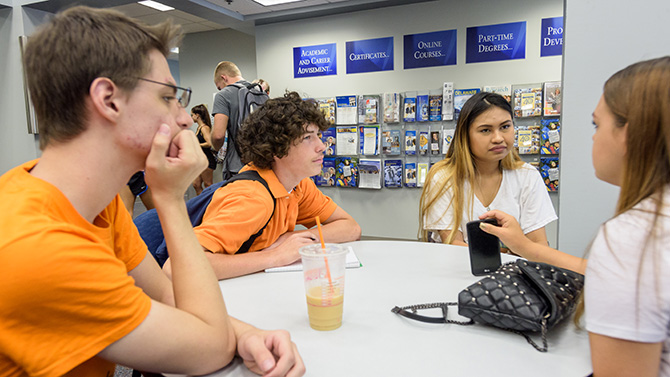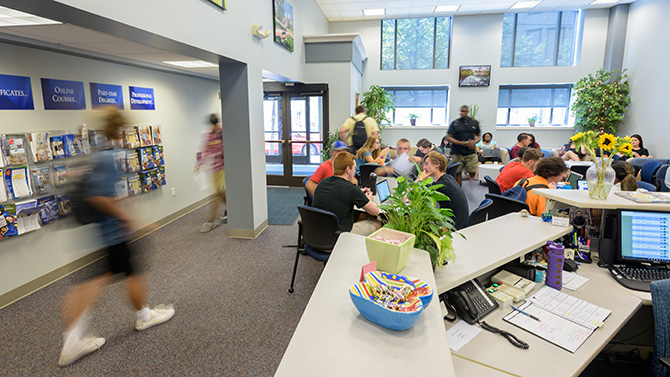

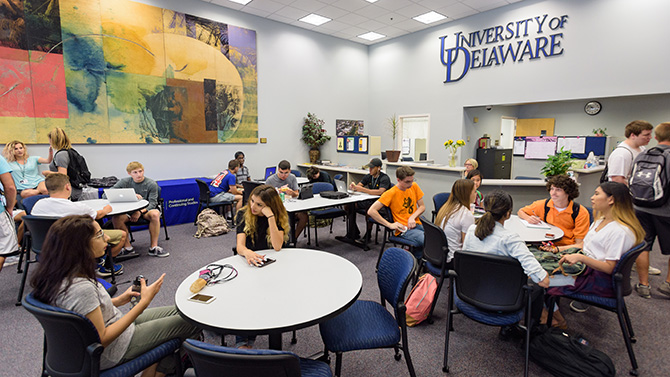
Associate in Arts Program grows
Photos by Evan Krape September 15, 2016
Students choose AAP two-year path to begin their UD experience
As the University of Delaware’s newest students settle into the routine of classes, studying and social activities in Newark, some 440 of their fellow classmates are doing the same in the Associate in Arts Program (AAP).
With a campus in each of Delaware’s three counties, small class sizes, specialized advisers, low tuition costs and a growing number of academic and social options, AAP is experiencing record enrollment, said David Satran, the program’s director.
“We see more and more students and parents who realize the cost-effective nature of the program and the advantages it offers,” Satran said. “It’s a pathway that students can choose — a pathway to a baccalaureate degree — as a way to begin their Blue Hen experience.”
AAP students are full-fledged UD students who enroll in a wide range of University classes taught by UD faculty members. Although most classes meet in space designated for use by UD on campuses of Delaware Technical Community College (DTCC), the program faculty and staff encourage AAP students to take advantage of all the opportunities the University offers.
When AAP students successfully complete their requirements for an associate degree, generally 60 credits taken over two years, they can transition to the Newark campus to finish their bachelor’s degree.
“It’s not a transfer, because they’re already UD students and their credits are UD credits,” Satran said. “It’s a transition, and we work to make it seamless for them.”
On the Georgetown campus, students can apply to the associate in arts degree through the College of Arts and Sciences or earn a two-year degree in elementary teacher education (ETE). By completing the associate in arts ETE program in Georgetown, students are eligible to enter the Newark program as juniors, well on their way to obtaining a bachelor of science degree in elementary teacher education.
As AAP graduates arrive in Newark to start their junior year, numerous resources are available to help make the transition a smooth one. Assistant Dean Latoya Watson directs the transition process.
The AAP, which is not a residential program, can be especially beneficial for students who always planned to commute from home, Satran said. Some prefer to live with their parents to save money, to help with family responsibilities or to continue jobs they held during high school, while others, especially in Kent or Sussex counties, choose not to relocate to Newark for their first two years at UD.
The program’s staff worked with University Admissions last spring to educate students and families throughout the state about the AAP option, and interest was strong, Satran said.
The Wilmington campus this fall has a record number of first-year students, about 259, while Georgetown has held steady with about 80 new students and Dover has increased slightly to about 102. Next school year, the AAP in Georgetown will expand its options for students with a new nursing program offered jointly with Beebe Healthcare’s Margaret H. Rollins School of Nursing.
In Wilmington, the campus itself has also expanded. While many classes continue to meet in dedicated space at DTCC, about half the classes now are held several blocks away in UD’s Downtown Center building at Eighth and King streets.
The Downtown Center has been used for decades for evening classes in the University’s Professional and Continuing Studies programs, but it now bustles with increased daytime activity as a growing number of AAP classes meet there. The building also has a common area where students can gather.
Another expansion occurred in Wilmington last year, when some evening AAP classes began meeting at Arsht Hall on the University’s campus on Pennsylvania Avenue.
At the end of August this year, the program held special events at its locations statewide to welcome new students, and plans are underway to increase other opportunities for student activities. Speakers from the Newark campus come to talk to AAP students about subjects ranging from library services to student health and wellness programs.
“We do our best to bring the campus here,” said Lisa McInnis, site coordinator for the Downtown Center. “When they transition to Newark for their last two years, we want them to feel comfortable right away.”
In recent years, nearly 90 percent of AAP graduates typically move on to the main campus, where some 70 percent earn their bachelor’s degrees.
Students say that friends often mistakenly think they attend DTCC or that AAP was a kind of consolation prize for not enrolling immediately in a four-year college program. But many say they specifically wanted to start college this way.
For Shaun McGuckin of Hockessin, who planned to commute to UD even if he attended the Newark campus, saving money by choosing AAP seemed like a smart idea. He said he also likes the smaller classes and personal attention that’s available as he explores possible majors from business to computer science.
“Plus, I have a UD student ID, so I can use the gym in Newark or go to events on campus if I want to,” he said.
Mauriah Lewis of Wilmington, who is interested in a major in music, admitted that it was “a fear of big classes” that first attracted her to the AAP.
“The classes are smaller here, and I see a lot of people I know, so I kind of feel at home,” she said. “Plus, I knew it was a good program, and that’s the important thing.”
Evan Krape
Peter Rees, professor emeritus of geography, teaches an Associate in Arts Program class at UD's Downtown Center.
Evan Krape
An Associate in Arts Program student in class at UD's Downtown Center.
Evan Krape
Kuinera de Kramer-Lynch teaches an anthropology class.
Evan Krape
A student works in the Downtown Center lounge.
Evan Krape
Students check classes at the Downtown Center.
Evan Krape
Students get together in the Downtown Center lounge.
Evan Krape
The Downtown Center is a busy place with expanded Associate in Arts Program enrollment.
Contact Us
Have a UDaily story idea?
Contact us at ocm@udel.edu
Members of the press
Contact us at 302-831-NEWS or visit the Media Relations website

